Welcome to roboslyq's blog
IT技能成长的印记-
SpringCloud应用系列(3.2) feign负载均衡
1.文章列表
2. 项目依赖
- 注册中心:spring-cloud-eureka
- 服务提供者:spring-cloud-eureka-client
- 服务消费者: spring-cloud-feign-client
3.Feign消费端环境搭建
3.1 依赖导入
<dependency> <groupId>org.springframework.cloud</groupId> <artifactId>spring-cloud-starter-netflix-eureka-client</artifactId> </dependency> <dependency> <groupId>org.springframework.cloud</groupId> <artifactId>spring-cloud-starter-openfeign</artifactId> </dependency>3.2 修改启动引导类
package com.springcloudribbonclient; import org.springframework.boot.SpringApplication; import org.springframework.boot.autoconfigure.SpringBootApplication; import org.springframework.cloud.client.discovery.EnableDiscoveryClient; import org.springframework.cloud.client.loadbalancer.LoadBalanced; import org.springframework.cloud.openfeign.EnableFeignClients; import org.springframework.context.annotation.Bean; import org.springframework.web.client.RestTemplate; @SpringBootApplication //@EnableDiscoveryClient @EnableFeignClients public class SpringCloudRibbonClientApplication { public static void main(String[] args) { SpringApplication.run(SpringCloudRibbonClientApplication.class, args); } }3.3 创建具体消费类
package com.springcloudribbonclient.service; import org.springframework.cloud.openfeign.FeignClient; import org.springframework.web.bind.annotation.RequestMapping; import org.springframework.web.bind.annotation.RequestMethod; //Feign注解,value为服务提供者的serviceId @FeignClient(value = "SPRING-CLOUD-EUREKA-CLIENT") public interface FeignServiceDemo { //配置服务提供者的URI及相关参数,此注解与SpringMVC通用 @RequestMapping(value = "/hello", method = RequestMethod.GET, produces = "application/json; charset=UTF-8") String hello1(); }此类不需要具体实现,具体实现由代理技术生成
3.4 创建控制器类
package com.springcloudribbonclient.controller; import com.springcloudribbonclient.service.FeignServiceDemo; import org.springframework.beans.factory.annotation.Autowired; import org.springframework.web.bind.annotation.GetMapping; import org.springframework.web.bind.annotation.RestController; import org.springframework.web.client.RestTemplate; @RestController public class ConsumerController { //注入接口 @Autowired private FeignServiceDemo feignServiceDemo; @GetMapping(value = "/hello1") public String hello1() { String result = feignServiceDemo.hello1(); System.out.println("feigh:"+result); return result; } }1、控制器类请求路径为
/hello1。2、控制器类通过
feignServiceDemo来调用服务器提供的相应服务。3.4 application.properties配置
#应用名称 spring.application.name = feign-consumer #端口号 server.port=9000 #注册中心的地址 eureka.client.serviceUrl.defaultZone=http://localhost:8082/eureka/
-
JDK常见源码分析(1)Object
Object
Object对象是Java中所有对象的父类 。一共有12个方法。源码如下(JDK1.8):
package java.lang; public class Object { public Object() { } //native方法 private static native void registerNatives(); //native方法 public final native Class<?> getClass(); //native方法 public native int hashCode(); public boolean equals(Object var1) { return this == var1; } //native方法 protected native Object clone() throws CloneNotSupportedException; public String toString() { return this.getClass().getName() + "@" + Integer.toHexString(this.hashCode()); } //native方法 public final native void notify(); //native方法 public final native void notifyAll(); //native方法 public final native void wait(long var1) throws InterruptedException; //wait() 需要被try catch包围,中断也可以使wait等待的线程唤醒。 public final void wait(long timeout, int nanos) throws InterruptedException { if (timeout < 0) { throw new IllegalArgumentException("timeout value is negative"); } if (nanos < 0 || nanos > 999999) { throw new IllegalArgumentException( "nanosecond timeout value out of range"); } if (nanos > 0) { timeout++; } wait(timeout); } public final void wait() throws InterruptedException { this.wait(0L); } protected void finalize() throws Throwable { } static { registerNatives(); } }
-
个人计划 2019年技术学习
2019-03-092019年技术学习
时光如梭,大学的时光仿佛就像昨天,还历历在目,可实际上已经过去了八年之久。回首这过去八年,发现自己竟然没有留下什么有价值的东西。牛顿曾经说过:我看得远,是因为我站在巨人的肩膀上。虽然我不是什么巨人,只是一枚普普通过的老程序员,但还是希望将自己的经历经验记录下来,希望有缘人有机会可以看到对其有些帮助。至少是对自己过去的经验作一个总结,为后续的工作提供更好的发展。
山外山,天外天,自己自是一个普通的程序员。要自信但也不要自大。。
思想,是编程的核心。而知识的积累是思想的源泉。脚踏实地,做好技术。
本文主要是自己作的Java体系相关的技术。希望2019年能在基础方面有很好的提高。一切高深的技术源于基础,源于基本的算法。所以数据结构与算法,设计模式等是一切框架的基础。因此19年优先打好基础,但同时也要把握住技术趋势,知道技术发展方向。
形成自己的知识体系,进行总结,根据总结不断发散知识的知识体系
SpringCloud及Spring学会使用及背后源码阅读,了解其运行原理
比如eureka内部怎么保证强一致性,springcloud服务降级组件与原理
动态网关zuul原理
robbion负载均衡有几种
mysql同步原理
暂定基础
- (Java8)JDK常见类实现源码分析
- Java8 Stream编程
- React编程
- Java反射
- Java运行时内存模型
- Java GC
- Java字节码指令
- Java Classic文件组成结构
- Java字节码操作工具(javassit)
- 反射与AspectJ
- 枚举与泛型原理
- ThreadLocal使用
- JDK编译
- 性能监控及分析
设计模式
23种常见设计模式及应用
算法与数据结构
操作系统原理
-
SpringCloud应用系列(3.1) ribbon服务调用
1.文章列表
2. 项目依赖
- 注册中心:spring-cloud-eureka
- 服务提供者:spring-cloud-eureka-client
- 服务消费者: spring-cloud-ribbon-client
3.服务端环境搭建
3.1 依赖导入
<dependency> <groupId>org.springframework.cloud</groupId> <artifactId>spring-cloud-starter-netflix-eureka-client</artifactId> </dependency> <dependency> <groupId>org.springframework.cloud</groupId> <artifactId>spring-cloud-starter-netflix-ribbon</artifactId> </dependency>3.2 修改启动引导类
package com.springcloudribbonclient; import org.springframework.boot.SpringApplication; import org.springframework.boot.autoconfigure.SpringBootApplication; import org.springframework.cloud.client.discovery.EnableDiscoveryClient; import org.springframework.cloud.client.loadbalancer.LoadBalanced; import org.springframework.cloud.openfeign.EnableFeignClients; import org.springframework.context.annotation.Bean; import org.springframework.web.client.RestTemplate; @SpringBootApplication @EnableDiscoveryClient public class SpringCloudRibbonClientApplication { @Bean //定义REST客户端,RestTemplate实例 @LoadBalanced//开启负债均衡的能力 RestTemplate restTemplate() { return new RestTemplate(); } public static void main(String[] args) { SpringApplication.run(SpringCloudRibbonClientApplication.class, args); } }3.3 创建控制器类
package com.springcloudribbonclient.controller; import org.springframework.beans.factory.annotation.Autowired; import org.springframework.web.bind.annotation.GetMapping; import org.springframework.web.bind.annotation.RestController; import org.springframework.web.client.RestTemplate; @RestController public class ConsumerController { @Autowired private RestTemplate restTemplate; @GetMapping(value = "/hello") public String hello() { return restTemplate.getForEntity("http://SPRING-CLOUD-EUREKA-CLIENT/", String.class).getBody(); } }1、控制器类请求路径为
/hello2、控制器类通过
RestTemplate指定服务提供者的路径http://SPRING-CLOUD-EUREKA-CLIENT/。其中SPRING-CLOUD-EUREKA-CLIENT为服务提供者的应用名称。即spring.application.name属性对应的名称。3.4 application.properties配置
#应用名称 spring.application.name=spring-cloud-ribbon-client #端口号 server.port=8084 #注册中心的地址 eureka.client.serviceUrl.defaultZone=http://localhost:8082/eureka/3.4 启动测试
3.4.1 服务注册
访问测试路径:
http://localhost:8082/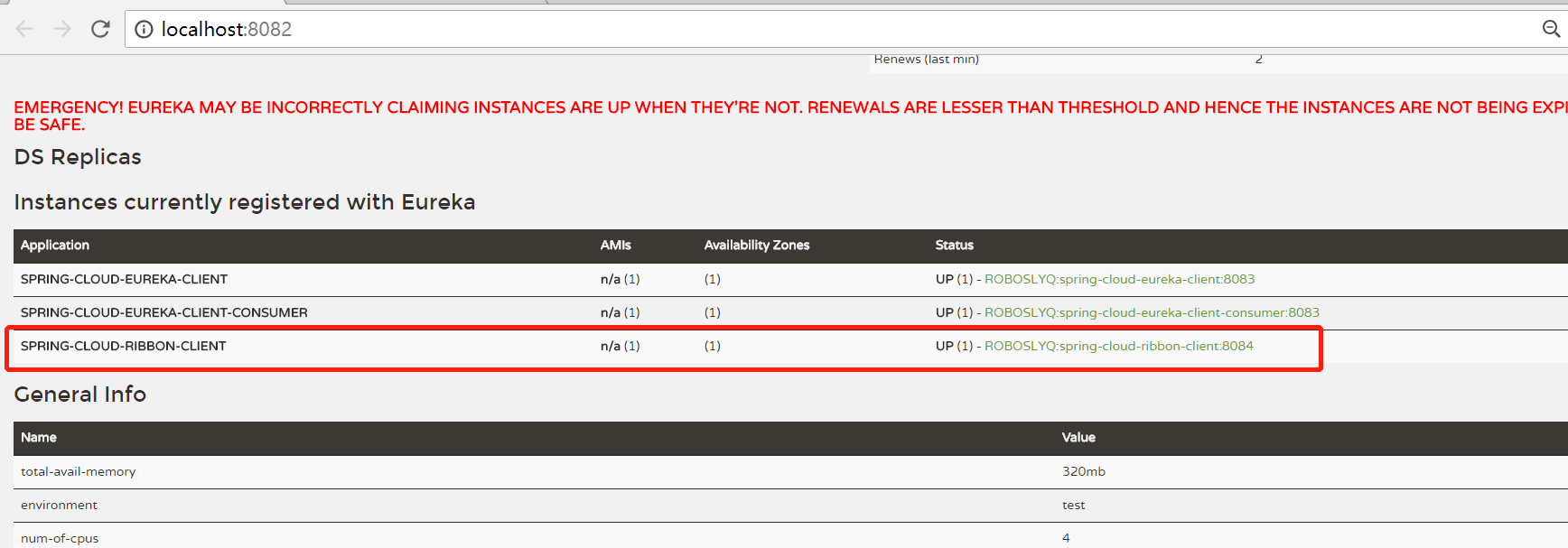
3.4.2 服务调用
访问测试路径:
http://localhost:8084/
4. 负载均衡实现
在前端的基础上,修改服务服务提供者的端口,启动多个提供者。然后再进行消费。
4.1 修改服务提供者代码
package com.roboslyq.springcloudeurekaclient; import org.springframework.beans.factory.annotation.Autowired; import org.springframework.beans.factory.annotation.Value; import org.springframework.boot.SpringApplication; import org.springframework.boot.autoconfigure.SpringBootApplication; import org.springframework.cloud.client.ServiceInstance; import org.springframework.cloud.client.discovery.DiscoveryClient; import org.springframework.cloud.client.discovery.EnableDiscoveryClient; import org.springframework.web.bind.annotation.RequestMapping; import org.springframework.web.bind.annotation.RequestMethod; import org.springframework.web.bind.annotation.RestController; import java.util.List; @SpringBootApplication //启用服务发瑞客户端 @EnableDiscoveryClient @RestController public class SpringCloudEurekaClientApplication { @Value("${server.port}") private int serverPort; //测试请求使用 @RequestMapping(value ="/hello",method = RequestMethod.GET) public String home() { return "hello:" + serverPort; } public static void main(String[] args) { SpringApplication.run(SpringCloudEurekaClientApplication.class, args); } }注入当前启动服务的端口,并且返回给调用者。调用者可以通过端口区分具体调用了哪个服务提供者。
## 4.2 调整服务提供启动端口
可以通过mvn工具打成jar包,然后指定启动端口。或者直接在IDEA,修改启动端口,如下图所示:
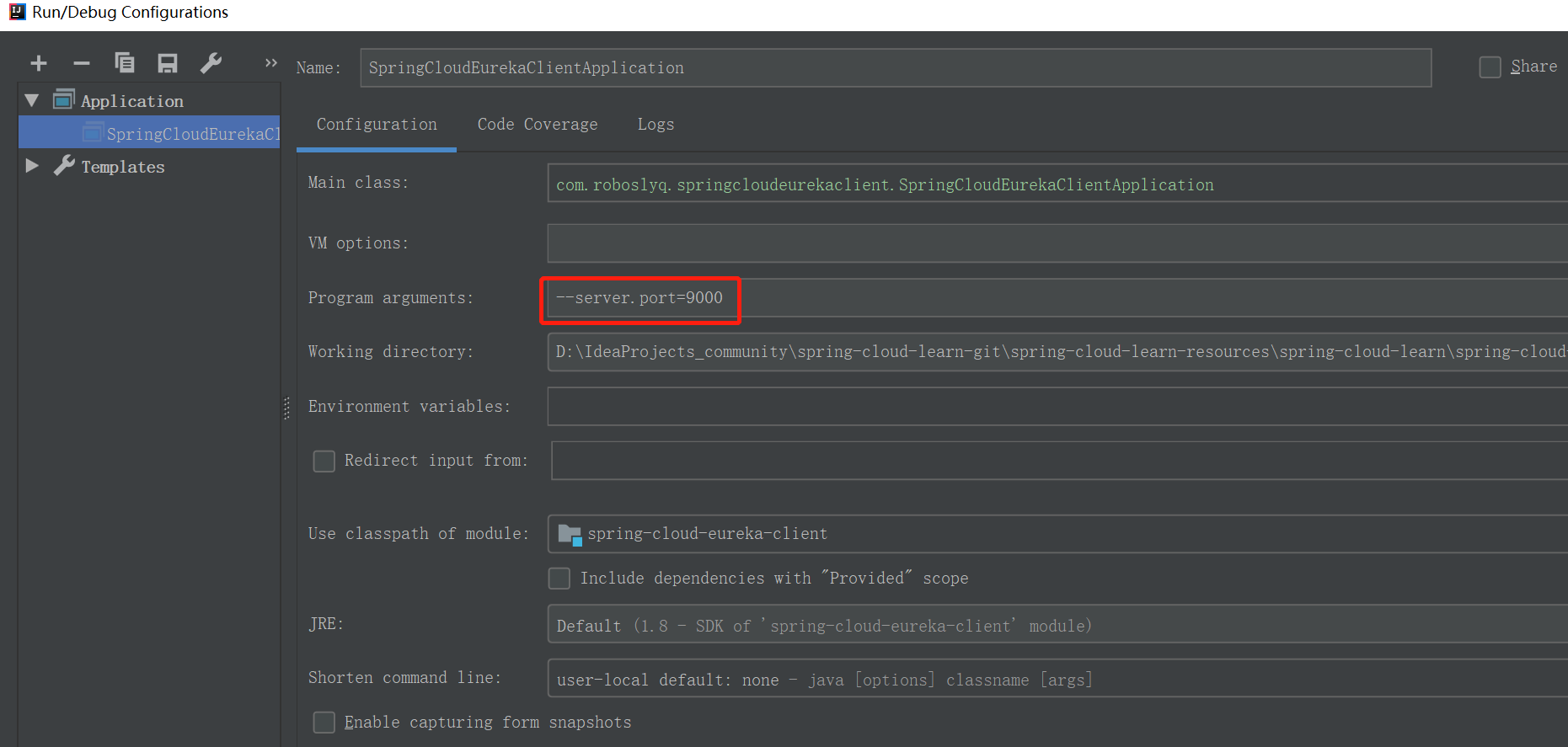
4.3 调整消费消费代码
package com.springcloudribbonclient.controller; import org.springframework.beans.factory.annotation.Autowired; import org.springframework.web.bind.annotation.GetMapping; import org.springframework.web.bind.annotation.RestController; import org.springframework.web.client.RestTemplate; @RestController public class ConsumerController { @Autowired private RestTemplate restTemplate; @GetMapping(value = "/hello") public String hello() { String result = restTemplate.getForEntity("http://SPRING-CLOUD-EUREKA-CLIENT/hello", String.class).getBody(); System.out.println(result); return result; } }添加打印代码,打印服务提供者返回信息
4.4测试结果
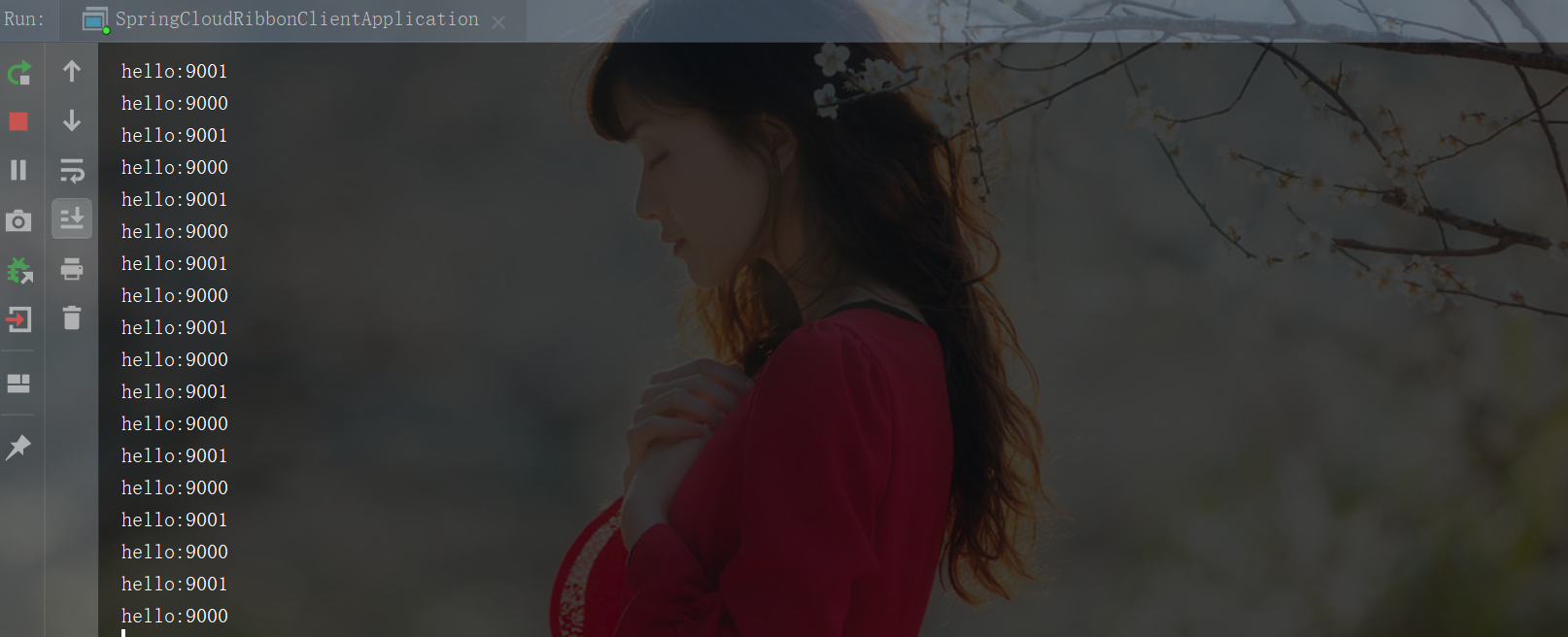
由结果可见,对服务提供者实现比较均衡的轮询调用。
-
SpringCloud应用系列(2)eureka服务治理
1.文章列表
2. 服务端环境搭建
环境搭建具体步骤请参考本系列文章第一篇SpringCloud应用系列(1)config配置中心。
2.1 依赖导入
<dependency> <groupId>org.springframework.cloud</groupId> <artifactId>spring-cloud-starter-netflix-eureka-server</artifactId> </dependency>2.2 修改启动引导类
package com.roboslyq.springcloudeureka; import org.springframework.boot.SpringApplication; import org.springframework.boot.autoconfigure.SpringBootApplication; import org.springframework.cloud.netflix.eureka.server.EnableEurekaServer; @SpringBootApplication //启用eureka注册中心 @EnableEurekaServer public class SpringCloudEurekaApplication { public static void main(String[] args) { SpringApplication.run(SpringCloudEurekaApplication.class, args); } }2.3 application.properties配置
#应用名称 spring.application.name = spring-cloud-eureka #应用端口 server.port = 8082 #actuator配置 management.endpoint.enable-by-default = false management.endpoint.env.enabled=true management.endpoint.health.enabled=true management.endpoint.info.enabled=true management.endpoints.web.exposure.include = env #eureka相关配置 eureka.instance.hostname = localhost #registerWithEureka=true ,自已会注册 eureka.client.registerWithEureka = false #如果fetch-registry = true , 则去Eureka Server拉取注册信息 eureka.client.fetchRegistry = false eureka.client.serviceUrl.defaultZone = http://${eureka.instance.hostname}:${server.port}/eureka/2.4 启动测试
访问测试路径:
http://localhost:8082/
3 客户端环境搭建
3.1 依赖导入
<dependency> <groupId>org.springframework.cloud</groupId> <artifactId>spring-cloud-starter-netflix-eureka-client</artifactId> </dependency>3.2 修改启动引导类
package com.roboslyq.springcloudeurekaclient; import org.springframework.boot.SpringApplication; import org.springframework.boot.autoconfigure.SpringBootApplication; import org.springframework.cloud.client.discovery.EnableDiscoveryClient; import org.springframework.web.bind.annotation.RequestMapping; import org.springframework.web.bind.annotation.RestController; @SpringBootApplication //启用服务发瑞客户端 @EnableDiscoveryClient @RestController public class SpringCloudEurekaClientApplication { //测试请求使用 @RequestMapping("/hello") public String home() { return "Hello world"; } public static void main(String[] args) { SpringApplication.run(SpringCloudEurekaClientApplication.class, args); } }3.3 修改配置文件
spring.application.name = spring-cloud-eureka-client server.port = 8083 #配置注册中心地址 eureka.client.serviceUrl.defaultZone = http://localhost:8082/eureka/3.4 启动测试
刷新服务端测试路径:
http://localhost:8082/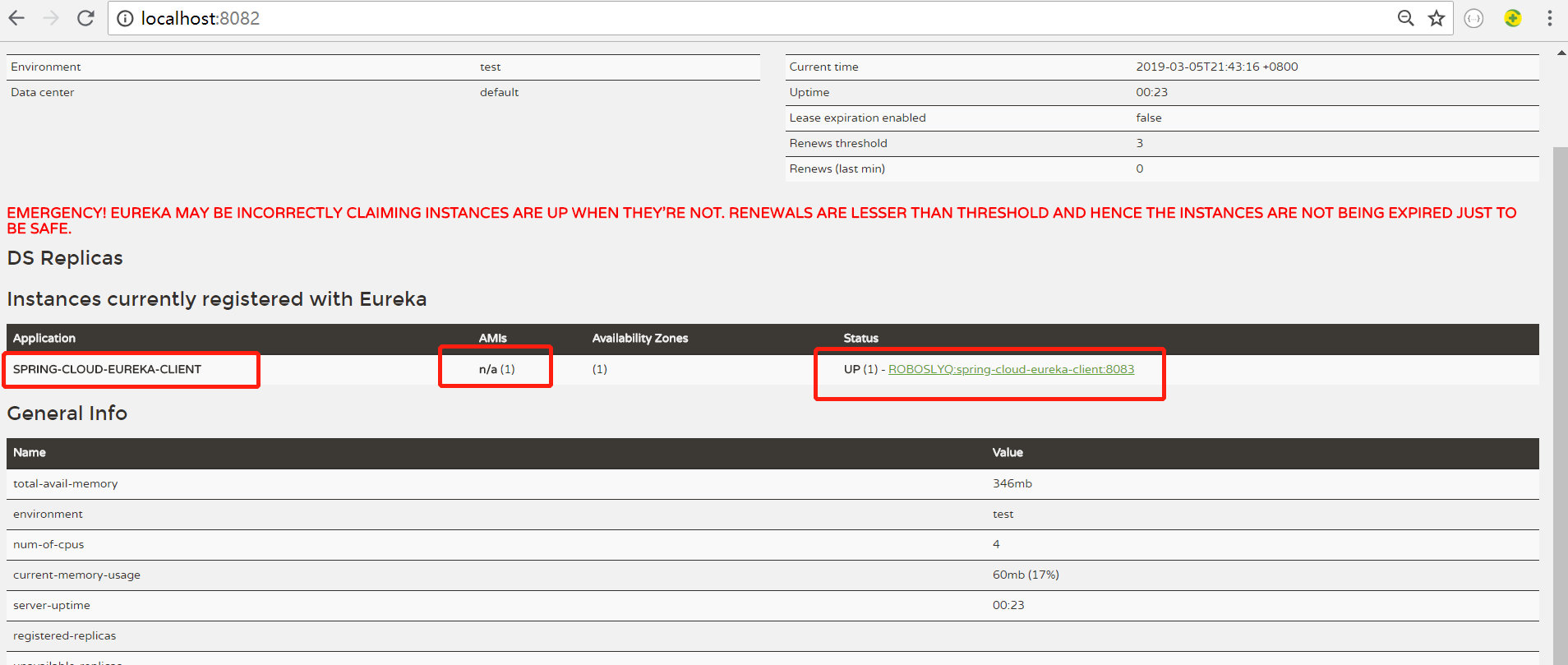
此图表明服务已经注册成功。
-
SpringCloud应用系列(1)config配置中心
1. 前言
本系列文章主要是以环境搭建实操为主,后续会有单独的系列来分析具体的实现原理。
本篇是本系列的文章第一篇,因此讲得有点啰嗦,一些细节操作问题会有提到。后续文章会化繁为简,一些基本的
操作可以参考此篇文章。
2. config server端环境搭建
2.1 SPRING INITIALIZR
如果是从0开始搭建springBoot(springCloud基于springboot搭建)相关项目,强烈推荐SPRING INITIALIZR。打开网站,如下图所示:
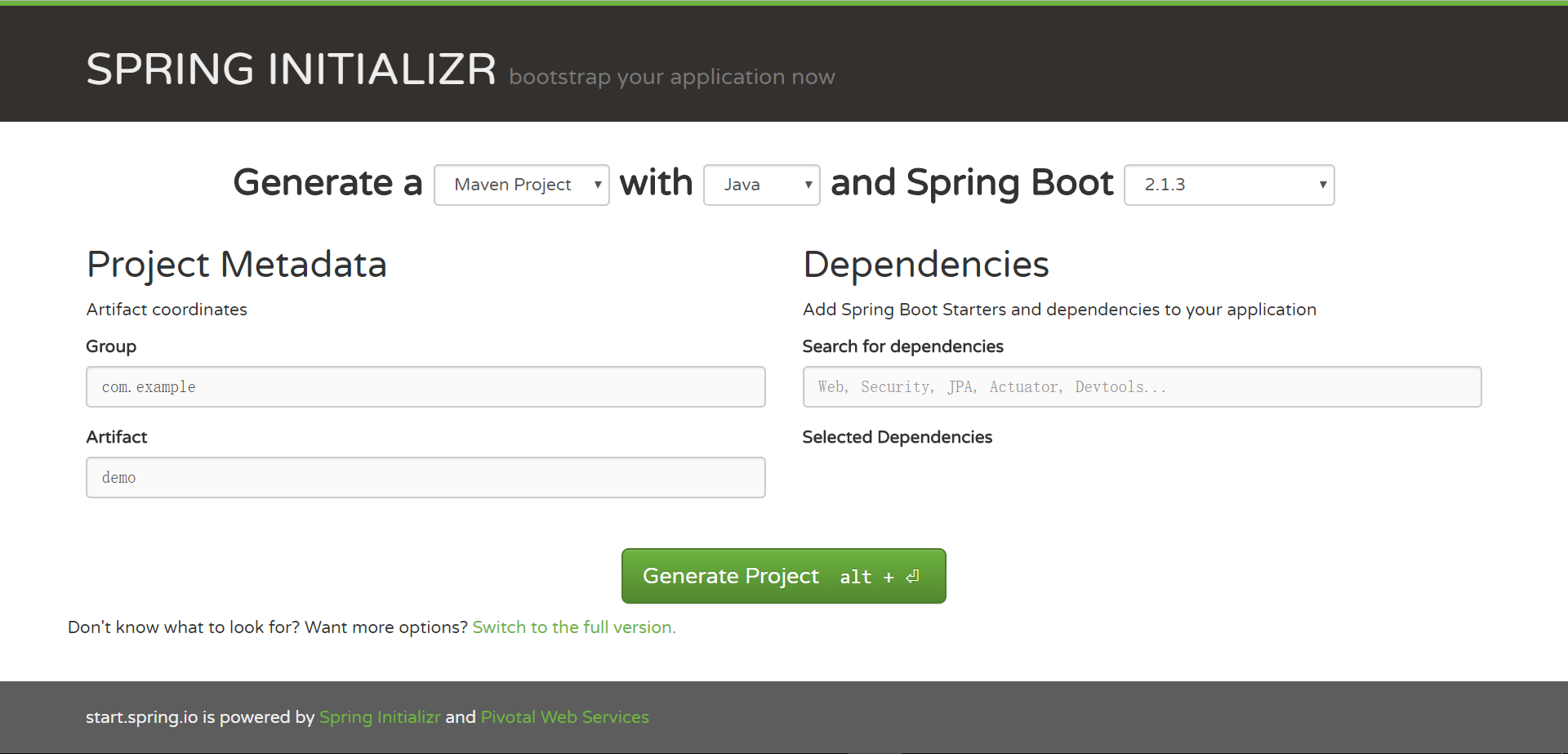
Generate a XXX with YYY and Spring Boot ZZZ 其中XXX指使用Gradle还是Maven进行项目管理。YYY指创建的项目语言是Java,Kotlin或Groovy。ZZZ是指具体的Spring boot版本。 Spring boot版本一旦确定之后,其它相关依赖也相关确定了。
我们选择录入相关信息如下: Group = com.roboslyq Artifact = spring-cloud-config-server Dependencies = Web Actuator Config Server
最后点击”Generate Project”即可生成相应的项目。
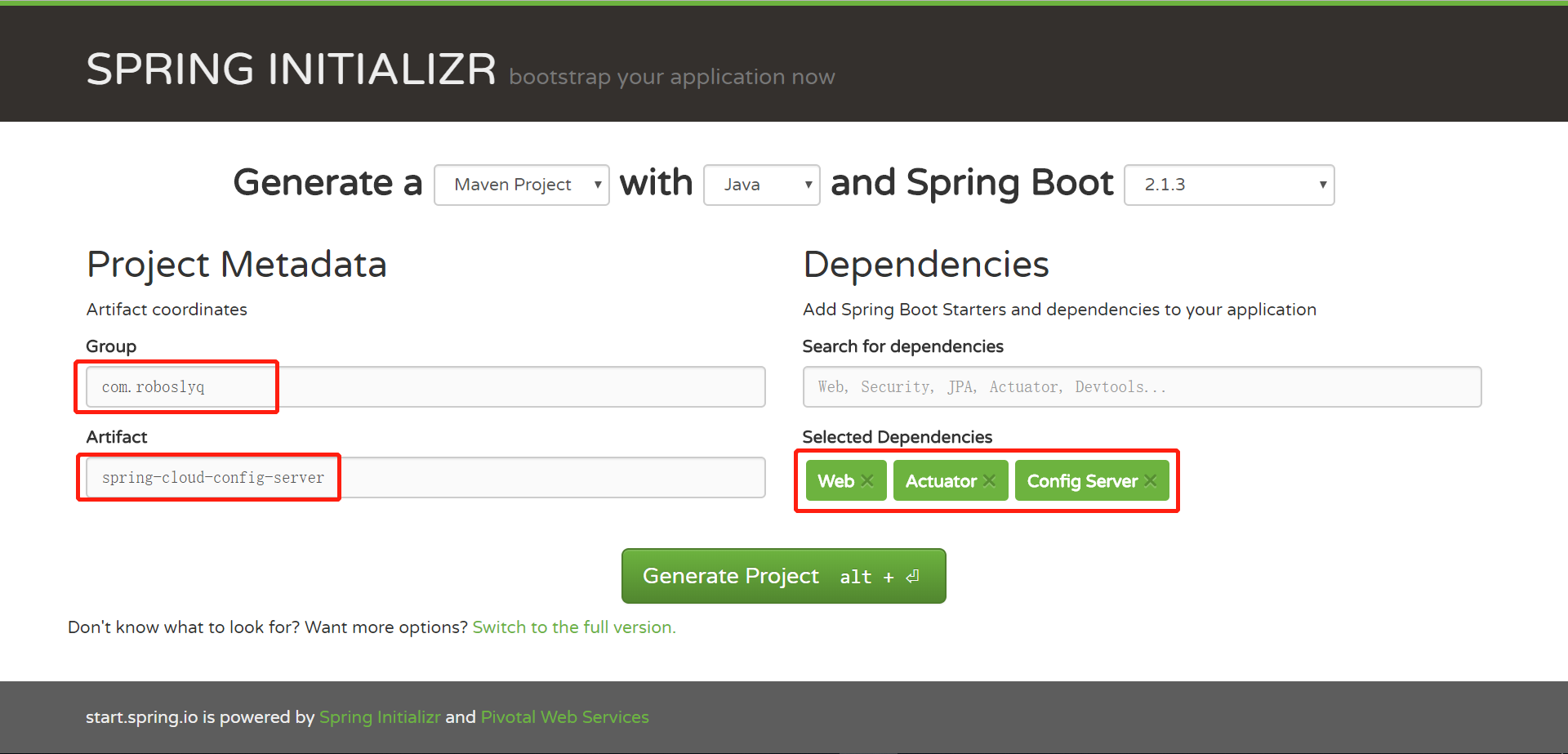
2.2 导入IDEA
2.2.1 项目结构
解压上面生成的压缩包,目录结构如下:
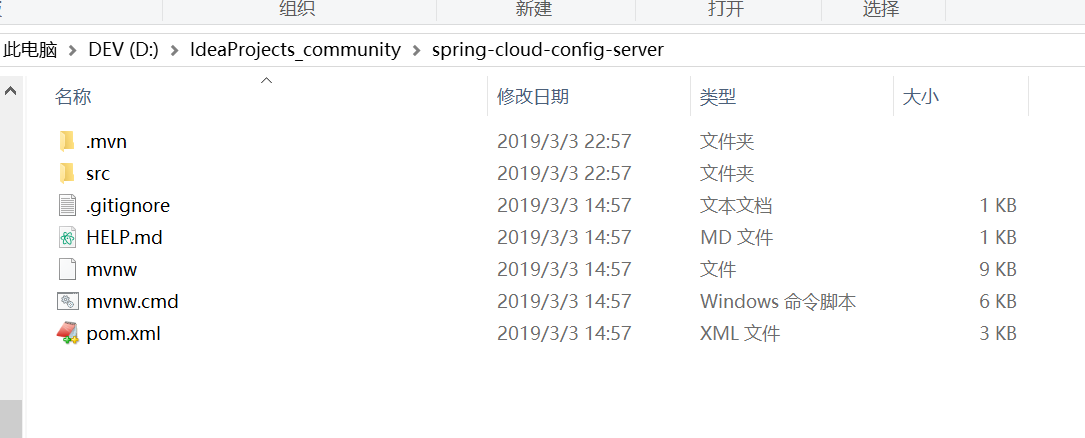
2.2.2 POM依赖
将其导入IDEA(在IDEA中直接打开pom.xml文件即可)
<?xml version="1.0" encoding="UTF-8"?> <project xmlns="http://maven.apache.org/POM/4.0.0" xmlns:xsi="http://www.w3.org/2001/XMLSchema-instance" xsi:schemaLocation="http://maven.apache.org/POM/4.0.0 http://maven.apache.org/xsd/maven-4.0.0.xsd"> <modelVersion>4.0.0</modelVersion> <!-- 标准的Spring boot项目 --> <parent> <groupId>org.springframework.boot</groupId> <artifactId>spring-boot-starter-parent</artifactId> <version>2.1.3.RELEASE</version> <relativePath/> <!-- lookup parent from repository --> </parent> <groupId>com.roboslyq</groupId> <artifactId>spring-cloud-config-server</artifactId> <version>0.0.1-SNAPSHOT</version> <name>spring-cloud-config-server</name> <description>Demo project for Spring Boot</description> <!-- 指定Java编译版本及SpringCloud版本 --> <properties> <java.version>1.8</java.version> <spring-cloud.version>Greenwich.RELEASE</spring-cloud.version> </properties> <dependencies> <!-- actuator依赖导入 --> <dependency> <groupId>org.springframework.boot</groupId> <artifactId>spring-boot-starter-actuator</artifactId> </dependency> <!-- spring mvc导入--> <dependency> <groupId>org.springframework.boot</groupId> <artifactId>spring-boot-starter-web</artifactId> </dependency> <!-- 配置中心服务器依赖--> <dependency> <groupId>org.springframework.cloud</groupId> <artifactId>spring-cloud-config-server</artifactId> </dependency> <dependency> <groupId>org.springframework.boot</groupId> <artifactId>spring-boot-starter-test</artifactId> <scope>test</scope> </dependency> </dependencies> <dependencyManagement> <dependencies> <dependency> <groupId>org.springframework.cloud</groupId> <artifactId>spring-cloud-dependencies</artifactId> <version>${spring-cloud.version}</version> <type>pom</type> <scope>import</scope> </dependency> </dependencies> </dependencyManagement> <build> <plugins> <plugin> <groupId>org.springframework.boot</groupId> <artifactId>spring-boot-maven-plugin</artifactId> </plugin> </plugins> </build> <repositories> <repository> <id>spring-milestones</id> <name>Spring Milestones</name> <url>https://repo.spring.io/milestone</url> </repository> </repositories> </project>2.3 添加相关配置
2.3.1 本地git配置
2.3.1.1 appplication.properties
修改
application.properties,添加如下配置:#应用名称 spring.appliacion.name = spring-cloud-config-server #服务端口 server.port = 8080 #actuator配置 management.endpoints.enabled-by-default = false management.endpoint.env.enabled=true management.endpoint.health.enabled=true management.endpoint.info.enabled=true management.endpoints.web.exposure.include = env #spring cloud config配置 spring.cloud.config.server.git.uri = ${user.dir}/src/main/resources/configsgit.uri当然可以写绝对路径,但为了保证通用性建议使用${user.dir}。在IDEA环境下,user.dir为当前项目所在路径。
2.3.1.2 新建配置文件
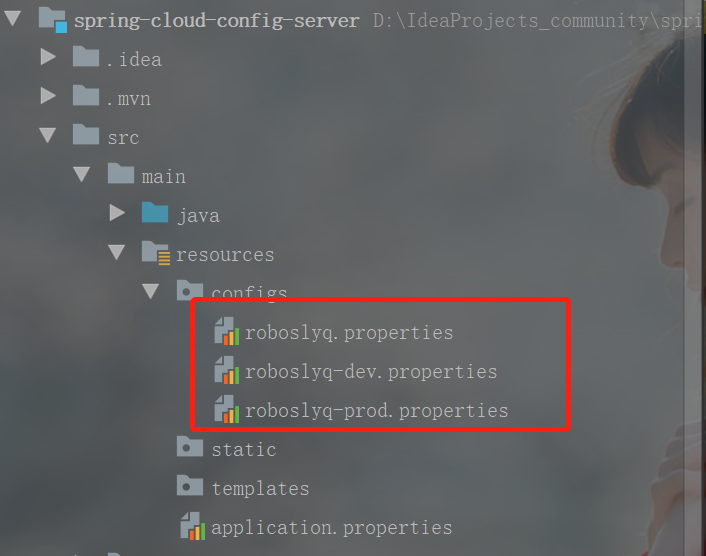
分别在每个配置文件中添加配置项
#default roboslyq.user.name = roboslyq #dev roboslyq.user.name = roboslyq.dev #prod roboslyq.user.name = roboslyq.prod2.3.1.3 添加到git控制
robos@ROBOSLYQ MINGW64 /d/IdeaProjects_community/spring-cloud-config-server/src/main/resources/configs $ git init Initialized empty Git repository in D:/IdeaProjects_community/spring-cloud-config-server/src/main/resources/configs/.git/ robos@ROBOSLYQ MINGW64 /d/IdeaProjects_community/spring-cloud-config-server/src/main/resources/configs (master) $ git add . warning: LF will be replaced by CRLF in roboslyq.properties. The file will have its original line endings in your working directory robos@ROBOSLYQ MINGW64 /d/IdeaProjects_community/spring-cloud-config-server/src/main/resources/configs (master) $ git commit -m "spring cloud config demo" [master (root-commit) e195202] spring cloud config demo 3 files changed, 4 insertions(+) create mode 100644 roboslyq-dev.properties create mode 100644 roboslyq-prod.properties create mode 100644 roboslyq.properties robos@ROBOSLYQ MINGW64 /d/IdeaProjects_community/spring-cloud-config-server/src/main/resources/configs (master)2.3.1.4启动类启用配置中心
package com.roboslyq.springcloudconfigserver; import org.springframework.boot.SpringApplication; import org.springframework.boot.autoconfigure.SpringBootApplication; import org.springframework.cloud.config.server.EnableConfigServer; @SpringBootApplication @EnableConfigServer public class SpringCloudConfigServerApplication { public static void main(String[] args) { SpringApplication.run(SpringCloudConfigServerApplication.class, args); } }2.3.1.5 启动项目测试
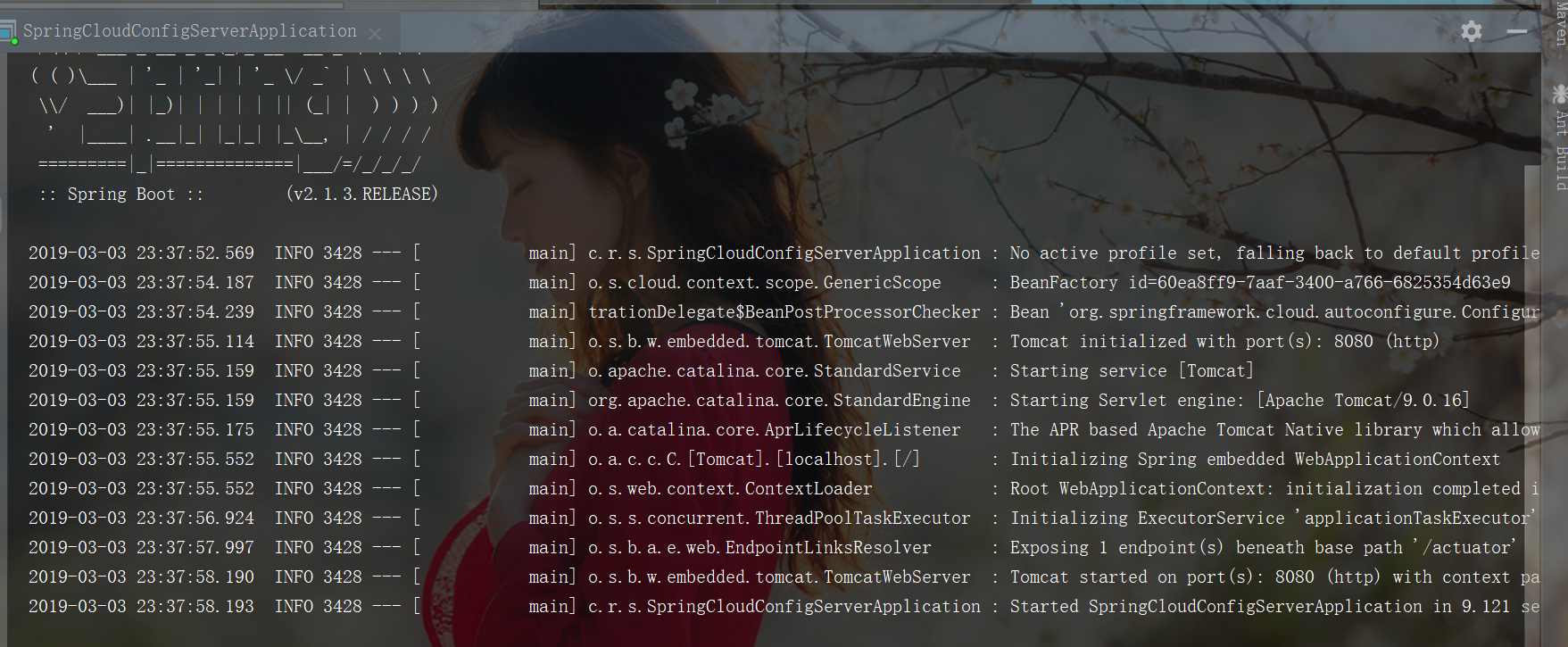
2.3.1.6 浏览器测试
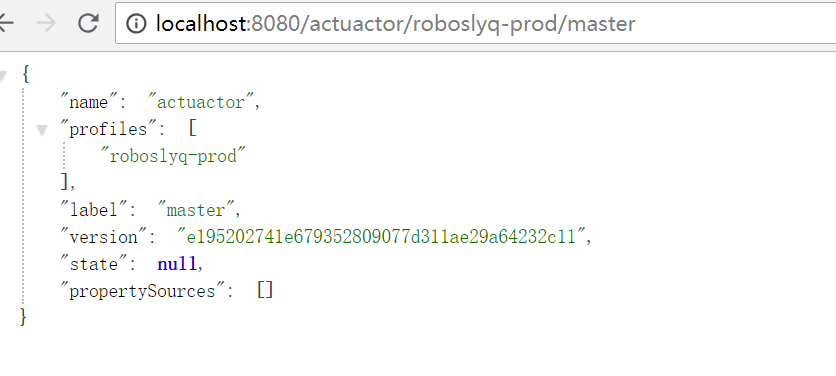
这个结果有点怪,配置文件中的Key和Value没有显示出来。但config-client可以正常获取相应配置。 我会在后面的config client证明这一点。
2.3.2 远程GIT配置
2.3.2.1 application.properties修改
将
spring.cloud.config.server.git.uri的值换成https://github.com/roboslyq/tmp.git。此前提是在自己的github上开立账号并且建立一个可以的仓库。#应用名称 spring.appliacion.name = spring-cloud-config-server #服务端口 server.port = 8080 #actuator配置 management.endpoints.enabled-by-default = false management.endpoint.env.enabled=true management.endpoint.health.enabled=true management.endpoint.info.enabled=true management.endpoints.web.exposure.include = env #spring cloud config配置 #spring.cloud.config.server.git.uri = ${user.dir}/src/main/resources/configs #配置config请求前缀,防止与其它请求冲突 spring.cloud.config.server.prefix = /config #github地址,可以添加用户名和密码 spring.cloud.config.server.git.uri = https://github.com/roboslyq/tmp.git #就否强制更新 spring.cloud.config.server.git.force-pull = true #更新频率 spring.cloud.config.server.git.refreshRate = 12.3.2.2远程仓库配置
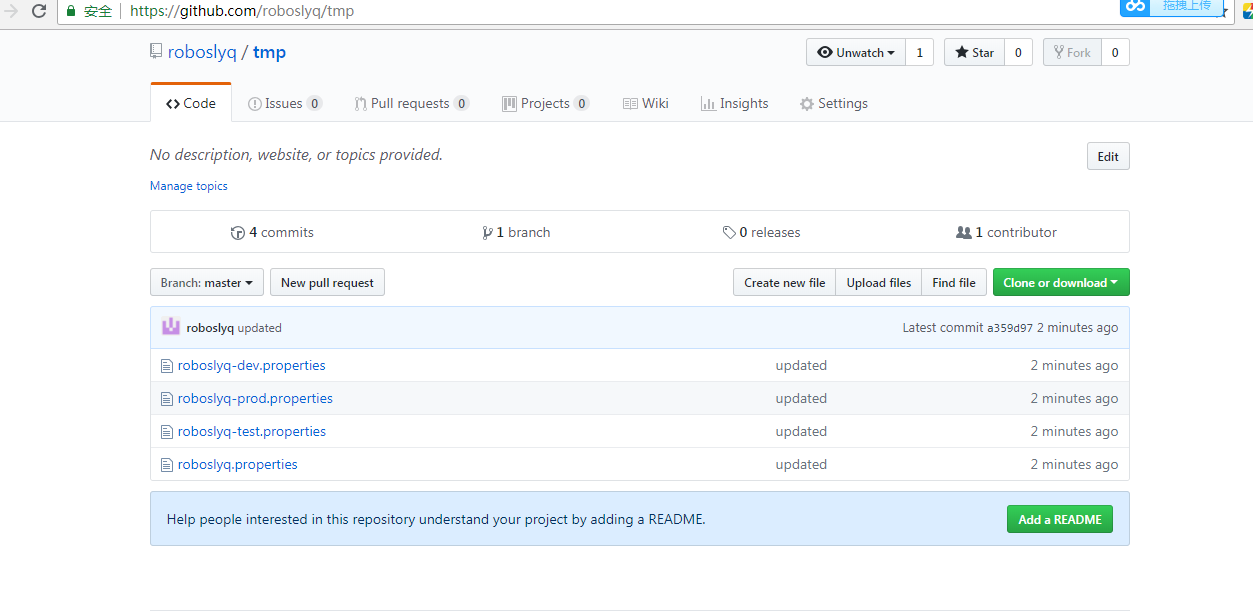
2.3.2.3 远程仓库测试
测试路径:http://localhost:8080/config/roboslyq-prod/master
测试结果如下:
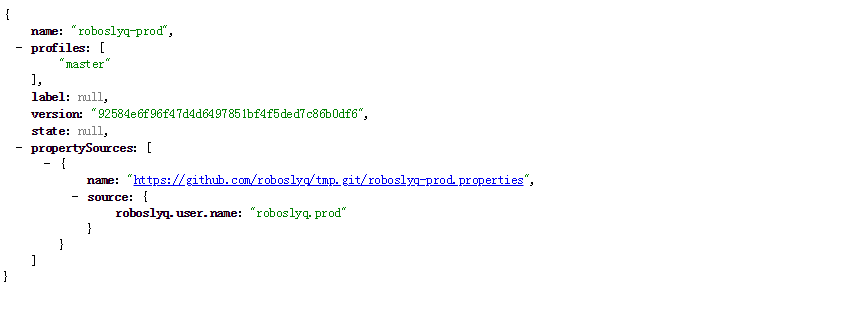
3. Config Client环境搭建
3.1 创建项目
具体创建流程与config server一致,只是pom.xml依赖变化如下:
<!-- 配置中心服务器依赖--> <dependency> <groupId>org.springframework.cloud</groupId> <artifactId>spring-cloud-config-server</artifactId> </dependency>客户端配置
<!-- 配置中心客户端依赖导入 --> <dependency> <groupId>org.springframework.cloud</groupId> <artifactId>spring-cloud-starter-config</artifactId> </dependency>3.2 添加相关配置
3.2.1 修改application.properties
#应用名称 spring.appliacion.name = spring-cloud-client #服务端口 server.port = 8082 #actuator配置 management.endpoints.enabled-by-default = false management.endpoint.env.enabled=true management.endpoint.refresh.enabled=true management.endpoint.health.enabled=true management.endpoint.info.enabled=true management.endpoints.web.exposure.include = env,refresh3.2.2 添加bootstrap.properties
spring.cloud.config.uri = http://localhost:8080/ spring.application.name = roboslyq spring.profiles.active = prod,devspring.cloud.config.uri与config Server端的IP与端口相对应。
spring.application.name与config Server端维护的git仓库配置文件相对应。
spring.profiles.active是config Server维护的版本应用配置的版本应用。
config Server中配置的git路径下的配置文件与具体客户端应用的映射关系如下:
/{application}/{profile}[/{label}] /{application}-{profile}.yml /{label}/{application}-{profile}.yml /{application}-{profile}.properties /{label}/{application}-{profile}.properties3.2.3 修改application.properties
package com.roboslyq.springcloudconfigclient; import org.springframework.beans.factory.annotation.Autowired; import org.springframework.beans.factory.annotation.Value; import org.springframework.boot.SpringApplication; import org.springframework.boot.autoconfigure.SpringBootApplication; import org.springframework.core.env.Environment; import org.springframework.web.bind.annotation.RequestMapping; import org.springframework.web.bind.annotation.RestController; @SpringBootApplication @RestController public class SpringCloudConfigClientApplication { //配置中心配置的变量名称 @Value("${roboslyq.user.name}") private String userName; //从env中获取配置参数,可以实现参数动态更新 @Autowired Environment environment; //模拟获取用户信息,返回一个字符串。 //@valueName不能实现动态更新,需要重启服务器。environment.getProperty可以实现动态更新。 @RequestMapping("/getUser") public String user() { String realTimeUserName = environment.getProperty("roboslyq.user.name"); return "@valueName = "+userName+"<br/> envName = "+ realTimeUserName ; } public static void main(String[] args) { SpringApplication.run(SpringCloudConfigClientApplication.class, args); } }